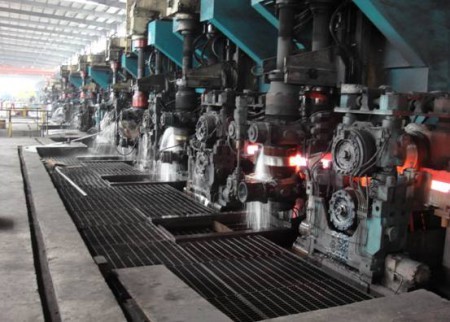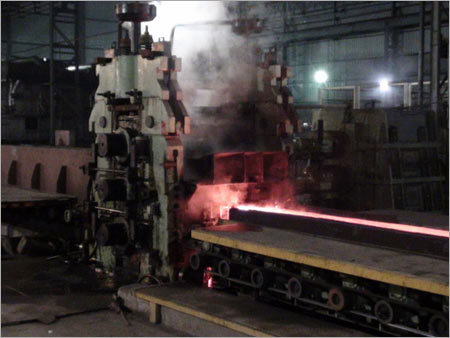Hot Rolling Mills
 What is Hot Rolling Mill?
What is Hot Rolling Mill?
A rolling mill is a device meant for pressure shaping of the metals or other materials between the rotating rolls. It is basically an automatic system or cluster of machines to perform both rolling and auxiliary operations including transportation of billets to heating furnaces and mill rolls, rolled material, metal after rolling, and many other functions. When rolled, the metal is first passed through a hot rolling mill. The metal is passed several times through it due to which the thickness of the metal considerably reduces.
What are Applications of Hot Rolling Mills?
The hot rolling mills are used for pressure shaping of the metal objects or other materials between the rotating rolls when temperature of the metal is kept above its recrystallization temperature. It is basically an automatic system or cluster of machines to perform both rolling and auxiliary operations including transportation of billets to heating furnaces and mill rolls, rolled material, metal after rolling, and many other functions. When rolled, the metal is first passed through a hot rolling mill. The metal is passed several times through it due to which the thickness of the metal considerably reduces. These hot rolling mills are mostly used to process angles, rods, sheets, channels, beams, etc. made from steel, iron, aluminum, and other metals.
Purpose of Hot Rolling Mills:
The main purpose of this mill is to repeatedly heat the semi-finished steel or any other metal slab to nearly their melting points. It then rolls them thinner and longer with the help of successive rolling stands driven by the motors and finally coils the straightened sheet to be transported to the next process. It can roll slabs weighing up to 30 tons, 8 to 9 inches thick steel slabs and up to 36 feet long into fine strips of thickness 1/16 inches.
How Does Hot Rolling Mill Work?
The mill rolls out coils by subjecting the slabs to extremely high temperatures in a heating furnace and high pressures through a successive arrangement of rolls. Because of the application of extremely high temperatures and pressures, the rolls which stay in contact with the hot steel band worn out. The continuous wear of roll adversely affects the fabrication and tolerances of the rolled products. In order to build resistance to breakage during the process, some rolls are replaced after every shift. However, change in the pressure settings of these rolls increases the possibility of obtaining low quality standards.
Advantages of Hot Rolling Mills:

- Less force
- Greater degree of deformation
- Improved structure and properties of the metal
- No Hardening
- Equipped with all safety features.
- Are easy to handle and operate.
- Durable and economical.
- Are made from highest grade metal.
- Highly efficient and can operate for long.
Limitations of Hot Rolling Mills:
- High resource input & costs for heating
- Increased wear and reduced standing time
- Continuous maintenance
Other Features of Hot Rolling Mills:
- Finishing standards
- Corrosion resistance
- Abrasion resistance
- Energy efficiency
- Longer operational life
Hot rolling mill is an important part of a rolling mill machinery which is used for various metal working process. To buy or for any query about hot rolling mills and machines feel free to contact below listed manufacturers of hot rolling mills who are trusted and established manufacturers rolling mills.
Browse Companies Listed Under - Hot Rolling Mills
| P.P. Rolling Mills Mfg. Co. Pvt. Ltd.
| | Exporter, manufacturer, trader, supplier
| | Product Range :- P.P. Rolling Mills Mfg. Co. Pvt. Ltd. from New Delhi is a leading trader of quality hot rolling mills, Shear, hot saw, rolling mill twin channel, pinion stand, etc. at best price from India.
| | Address: D-820, New Friends Colony, New Delhi, PIN Code - 110065, India.
| Mobile : +(91)-9810035999, +(91)-9810076425
Telephone: +(91)-(129)-4181100
Email: pankajkhanna@pprm.in, praneetkhanna@pprm.in, pprm@pprm.in
FAX No: +(91)-129- 4181124
Certifications: ISO 9001:2008 Certified
|  |
|
|
|
| Ugi Engineering Works Pvt. Limited
| | Exporter, manufacturer, trader, supplier
| | Product Range :- Contact Ugi Engineering Works Pvt. Limited for your any requirements to buy hot rolling mills, Helical gear box for 2 hi mill, gear box cum pinion stand for 4 hi mill, and many other tools & equipments from India.
| | Address: 23,The Mall Road, Kolkata, PIN Code - 700080, India.
| Mobile : +(91)-9830046487
Telephone: +91-(33)-25591304, +91-(33)-25512263
Email: kapoors@cal.vsnl.net.in, admin@universalgears.com
FAX No: +(91)-(33)-25595924
|  |
|
|
|
| A. R. Engineering Works
| | Exporter, manufacturer, trader, supplier
| | Product Range :- Buy quality, state of the art technology hot rolling mills, Helical gear box for 2 hi mill; gear box cum pinion stand for 4 hi mill from A. R. Engineering Works, New Delhi, India.
| | Address: 22, Okhla Industrial Estate, New Delhi, PIN Code - 110020, India
| Mobile : +(91)-9811018176, +(91)-9953356890
Telephone: +(91)-(11)-41612686
Email: arew22@hotmail.com, anil_khanna22@hotmail.com, info@argroup.net
FAX No: +(91)-(11)-41612339
|  |
|
|
|
| BHARAJ MACHINERIES PVT. LTD.
| | Exporter, Manufacturer, Supplier
| | Product Range :- BHARAJ MACHINERIES PVT. LTD. is well known for their best quality industrial machinery products like hot rolling mills, Shearing Machines, Lab Type Rubber Mixing Mill, Rotary Swagge, Forming Machine, etc. from India.
| | Address: Office & Unit No. 2 : Plot No. 12 & 13, Survey No. 66, Hissa No.1/2, Naik Pada, Village-Waliv, Vasai (East), Dist-Thane, PIN - 401208. Maharashtra, India.
| Mobile : +91-9820338110
Telephone: (95250)-2451332 / 3200403
Email: sales@bharajmachineries.com, info@bharajmachineries.com
FAX No: (95250)-2451332
|  |
|
|
|
| Ocean Extrusions
| | Manufacturer,supplier, exporter, trader
| | Product Range :- Contact Ocean Extrusions for your any buying requirements of hot rolling mills, cooling tank single pass, double pass types, accumulators, rotatory machines, extrusion tooling.
| | Address: Plot No.265, Road No.3, Phase-1, Kathwada GIDC, Kathwada, PIN-382110, Ahmedabad, Gujarat, India
| Mobile: +(91)-9724325400, (+91)-9724325401, (+91)-9227206356
Telephone: (079)-32994554, 079)-22902200
Email: sales@oceanextrusions.com, oceanextrusions@gmail.com
FAX No: (+91)-(79)-32994554
|  |
|
|
|
| ADHI SAKTHI PROJECTS
| | Manufacturer, supplier
| | Product Range :- ADHI SAKTHI PROJECTS is a well know manufacturing company which supplies hot rolling mills, Roll Mill, Laundry Soap Plant, Detergent Cake Plant, Liquid Detergent Plant, Liquid Based Shampoo Plant, etc across the world.
| | Address: 40/9, Earikkarai Road, Near Wipro Computers, Kothapurinatham, Thiruvandarkoil, Pondicherry, PIN-605102, India.
| Mobile : - +(91)-9443203221, +(91)-9442223221, +(91)-9894753715, +(91)-8588811550
Telephone: +(91)-(413)-2641049, +(91)-(413)-2641059, +91-(44)-22380086
Email: cskannan@adhisakthi.com, info@adhisakthiprojects.com, sales@adhisakthiprojects.com, inquiry@adhisakthiprojects.com
FAX No: +(91)-(413)-2641059
Certifications: ISO 9001:2008 Certified
|  |
|
|
|
| Bentex Industrials Pvt. Ltd.
| | Manufacturer, exporter, supplier, trader
| | Product Range :- Bentex Industrials Pvt. Ltd. manufactures and supplies Steel rolling mill machineries, steel rolling mill plant, pinion gear box, reduction gear box, shearing machine, hot rolling mills, and other machinery parts from India.
| | Address: C-55, Focal Point, Mandi Gobindgarh, PIN - 147301, Punjab, INDIA.
| Mobile : - +(91)-9815067929, +(91)-9815167929
Telephone: +(91)-(1765)-252929
Email: info@bentexindl.com, gm.sales@bentexindl.com, bentex96@gmail.com
FAX No: +91-(1765)-257678
Certifications: ISO 9001:2008 Certified
|  |
|
|
|
| BPA INTERNATIONAL PVT. LTD.
| | Exporter, manufacturer, trader, supplier
| | Product Range :- Buy top quality industrial machinery products like hot rolling mills, Construction Machines, Construction Equipments, Impact Crushers, Roll Crushers, Industrial Crushers, Impactors, Hammer Mills, etc. from BPA INTERNATIONAL PVT. LTD.
| | Address: 136, 1ST Floor, Utkalmoni Gopabondhu Sarani, Kolkata, PIN - 700008, West Bengal, India.
| Mobile : - +(91)-9831106550, +(91)-9163799526, +(91)-9339682839
Telephone: +(91)-(33)-22432678 / 40061368
Email:
FAX No: 91-33-22431276
|  |
|
|
|
| KS Electromech Pvt Ltd
| | Exporter, manufacturer, trader, supplier
| | Product Range :- Contact KS Electromech Pvt Ltd if you want good quality machinery products, tools & equipments like hot rolling mills, rolling mills, high speed carbon steel tube mills, high speed stainless steel tube mills from India.
| | Address: PLOT NO. E-10 (P), INDUSTRIAL FOCAL POINT, GT ROAD, SIRHIND SIDE MANDI GOBINDGAR, Gobindgarh , Punjab , India, Punjab 147301, India
| Mobile : +91-9216590496, +91-9216590495, +91-9216590495
Telephone: +91-1765-645595
Email: info@kselectromech.com
|  |
|
|
|
| |
Attract more buyers and get more
business Growth like never before.
|
 |
| |
|
| |
Tell suppliers exactly what you need
and make your product sourcing easy.
|
 |
| |
|
|
|
|
|
|
 What is Hot Rolling Mill?
What is Hot Rolling Mill?


